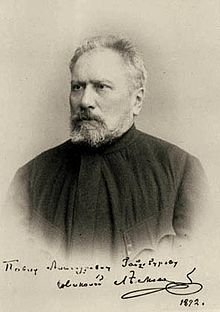The valley of tears (Nikolai Leskov)
The valley of tears , also Das Tränental ( Russian Юдоль , Judol ), is a story by the Russian writer Nikolai Leskow , which appeared in the June issue of Knischki Nedeli ( weekly booklet ) in 1892 .
On the occasion of the famine in the spring of 1892 in Russia Leskov recalls how he anno 1840 the age of nine in his Heimatgouvernement a similar disaster Oryol - more precisely in the districts of Orel , Mtsensk and Maloarkhangelsk - experienced.
content
The disaster began with the drought at the end of April. Carrying the holy images out into the field did not help. A clairvoyant was appointed. He tried his luck. It did not rain. Not even dew fell. The last resort, a candle made from the fat of a deceased drinker, almost helped. Their burning down in the field brought a dark wall of clouds. But it didn't rain down because the leather Yegor, a stray saddler, got in the way. Three farmers in the field kill the troublemaker.
The following winter is hard. Little Vasjonka freezes to death under the roof of her mother Agrafena's house. The mother and son Jegorka freeze to death on the way home from the cemetery.
The fron farmers of the stingy bachelor Major Alymow have to temporarily soak the seeds in manure made from horse manure. This means that the last rye cannot be consumed.
Leskov tells of Yefim, the pardoned. Previously, Jefim had stolen consecrated Easter bread and ate it alone. For this God had struck him crookedly, but then withdrew the punishment. Since then, one arm of Jefim had withered and from then on he made his way as a prayer and soothsayer. In any case, Jefim had fueled the rumor of rampant man-eating with one of his false stories. Ten versts from where Leskov's parents lived, a mother could no longer watch her four children starve. On Christmas Eve she slaughtered her newborn baby, put the boiled meat in front of the children and hanged herself from a rafter. As well as the Mar. Leskow corrects it with the truth: two teenage girls, alone at home, had slaughtered a lamb from a strange farm and had been watched by a little boy who was at home on the strange farm. When he persistently accused the girls of the crime, he was killed by the two with the butcher's knife. When the girls tried to burn the corpse, the smell of burning gave them away. Both confessed and went to jail.
Leskov has another story from the lips of Jefim: An old woman had served with the gentlemen in Oryol, saved up and spent the evening of her life in her home village Motyli. The resident soldier's wife was on their savings had traveled their aunt from, strangled them and found only one and a half rubles. She stood on it. When the perpetrator was flogged on Ilyinskaya Square in Oryol, she had screamingly protested her innocence.
"Hunger is a bad friend of virtue," writes Leskow and tells the story of the cat thugs. Some women who could not sell their fresh cat meat sold their female honor at the same time.
Everything in life has an end - including the famine in Oryol Governorate. The sick stayed behind. The symptoms: "First the head hurts, then it stings in the stomach, and then the person becomes very weak and lies there until his face turns black and it's gone." Leskov's father fetched his sister Pelageja Dmitrijewna, called Aunt Polly , according to Oryol. The fearless aristocratic aunt builds and runs a makeshift hospital with her friend Hildegard Wassiljewna, a Quaker from England . Leskov's mother, who was asked to take care of the sick, canceled the sister-in-law for fear of infection. Leskov's father, however, courageously helps.
Leskow puts the title of the story in Aunt Polly's mouth. The aunt characterizes the above-mentioned districts: "Here is the valley of tears." The people who would have forgotten the Most High in need must be forgiven.
Major Alymow wants to sue his farmers with the governor because they have consumed the contaminated seeds in his absence. Leskov's father has difficulty appeasing the curmudgeon.
reception
- According to Setschkareff, the text reads like an autobiography, but is "almost pure fiction".
- Reissner puts the story in a “disillusioning description of country life” of that time - like Chekhov's The Peasants and In the Gorge .
literature
German-language editions
Output used:
- The valley of tears. German by Wilhelm Plackmeyer. P. 154–265 in Eberhard Reissner (Ed.): Nikolai Leskow: Collected works in individual volumes. The valley of tears. 587 pages. Rütten & Loening, Berlin 1973 (1st edition)
Secondary literature
- Vsevolod Sechkareff : NS Leskov. His life and his work. 170 pages. Verlag Otto Harrassowitz, Wiesbaden 1959
Web links
- The text
- Entry in the Laboratory of Fantastics (Russian)
- Entry in WorldCat
See also
Individual evidence
- ↑ Russian Книжки Недели , monthly literature supplement to the Sankt Petersburg weekly newspaper Неделя ( The Week , 1866–1901)
- ↑ Setschkareff, p. 137, 5. Zvo
- ↑ Russian Мотыли
- ↑ Edition used, p. 244, 16. Zvo
- ↑ Edition used, p. 246, 5. Zvo
- ↑ Setschkareff, p. 137, 5th Zvo to p. 138, 15th Zvu
- ↑ Setschkareff, p. 137, 8th Zvu
- ^ Reissner in the follow-up to the edition used, p. 561, 4th Zvu
